Berlin: “Silicon Valley on the Spree” heading toward a very bright future with eye still on a very dark past

BERLIN — I like a country that admits its mistakes. It’s why I like Germany. It’s a country that has gone from arguably the biggest human degradation in man’s history and economic collapse to the fourth largest economy in the world. It took one generation to do it.
How many generations will it take for the U.S. to acknowledge the savagery of slavery with more than just token monuments? Or the Vietnam War? Or the Iraqi War? Last month the city of New Orleans tried to remove the monuments of four figures from the Confederacy and the mayor received death threats. There are various plaques dedicated to ex-slave Frederick Douglas, a leader in the abolitionist movement. Memphis, Tenn., and Birmingham, Ala., have Civil Rights museums. But America’s acknowledgement of its systematic racism pretty much stops there.
Washington has the Vietnam Memorial where 58,000 dead Americans are listed. I don’t imagine it will ever share concrete with anything reading “Iraq” and “War” in the same sentence.

Meanwhile, all over Berlin you can find chilling, haunting memorials to Germany’s ugly involvement in the Holocaust and communism. A four-story museum is dedicated entirely to the evils of Stasi, East Germany’s secret police. The Stasi prison still stands, as is, giving three tours a day to show what they did to prisoners who merely had a negative thought about their lovely lives in East Germany. A Holocaust Memorial was erected as recently as 2005 and covers a space the size of a football field. A DDR Museum shows what life was like under communism, a system that strives for mediocrity, a quest that undermines all human emotion and drive.
I took Marina here for her birthday last weekend. OK, so touring grotty, 30-year-old prison cells isn’t an Italian woman’s idea of romance. However, she’d never been here and I’d never been as a tourist. I came here for the 2006 World Cup final when Italy beat France. I remember that World Cup for another reason. Crisscrossing the country, I talked to Germans who said the German team’s run to the semifinals marked the first time since the disastrous end of World War II that Germans showed national pride. The red, black and yellow German flag flew from windowsills. People wore the flags like capes. The sounds of “DEUTSCH-LAND! DEUTSCH-LAND!” became a national mantra.
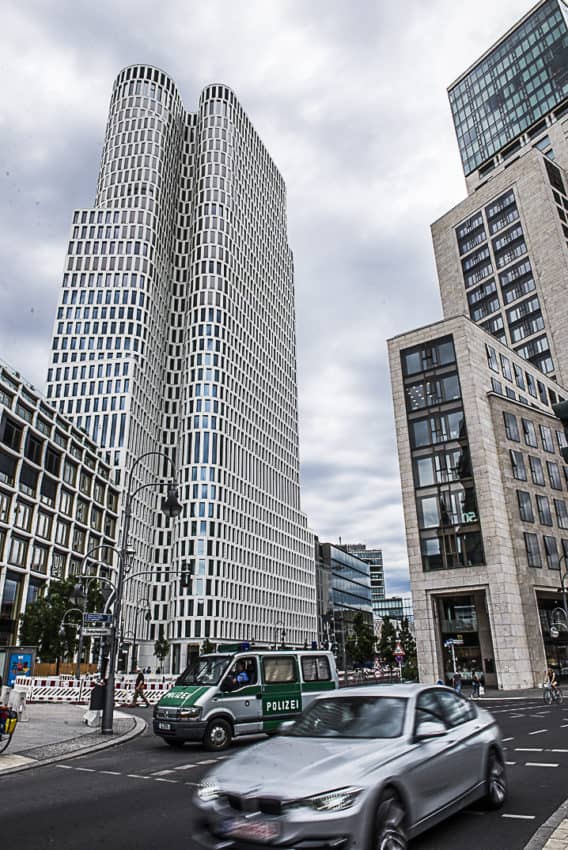
In years preceding the World Cup, whenever I talked to Germans about World War II, they gave a knowing nod. They acknowledge it. Now, can’t we move on? It’s like me when I talk about Vietnam or Iraq — or now, about Donald Trump. (I still refuse to defecate on the office of the presidency by putting that title before his name.)
Yet today in the U.S., the flag of Dixie, the flag of the Confederacy which fought for slavery in the Civil War, flew over the state house in Columbia, S.C., until two years ago. It’s still waved throughout the South, particularly at Trump rallies. Sarah Palin, the one-time vice-presidential candidate and all-time dingbat, once posted on Facebook photos of the Confederate flag and Planned Parenthood logo. She wrote, “Which symbol killed 90,000 black babies last year?”
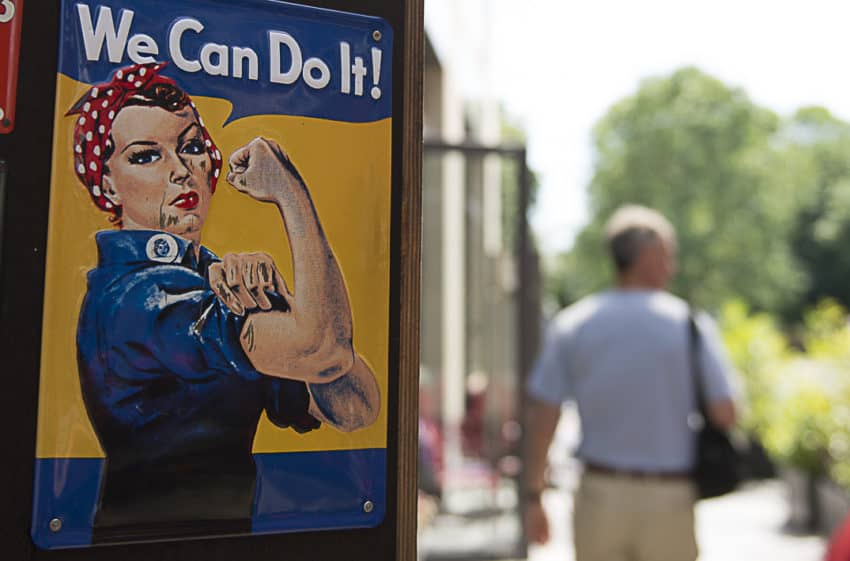
My one regret from my travels is I never visited Berlin during my trip around the world in 1978-79. I frankly didn’t think I had time to make the four-hour train ride from the East German border to West Berlin, a beacon of freedom inside a dark, foreboding communist country. I found it hard to imagine living in a dynamic, progressive city like Berlin, even in the ‘70s, and you can cross a street and step into a world of oppression, torture and paranoia. Imagine living in West Berlin. You could drive three hours and still be behind the Iron Curtain, in the middle of nowhere.
It’d be like living in Omaha except the sausage is better.
On this trip I wanted to see the black hole of East Germany. Marina demurred (actually I think she signaled with a fist), choosing instead to visit Berlin’s excellent photography museum. The Stasi museum is in the far east side of Berlin. It’s a good 20-minute tram ride from Checkpoint Charlie, the Berlin Wall’s main East-West crossing point until its destruction in 1989. Checkpoint Charlie, where the little checkpoint shack remains, has since turned into Berlin’s biggest tourist trap. It’s at a crossroads full of souvenir stores and two guys posing as American soldiers with tourists holding selfies. What was once East Berlin has become commercialized to where it could pass for downtown Singapore. East Berlin’s dilapidated buildings and government offices have been replaced by the likes of Max Mara, Starbucks and a Westin Grand hotel. A Porsche convertible passed me carrying two beautiful blondes dressed as if they were late for a catwalk.
As the tram went farther east, more of the old East Berlin materialized. Old red brick buildings. Ugly yellow apartment houses that looked like identical burnt match sticks. Cement business offices. A bombed-out, two-story concrete building looked like the city never touched it after Allied forces did. I passed an old sports hall with crude images of athletes painted on the walls and sporting the rounded roof characteristic of East European sports facilities.
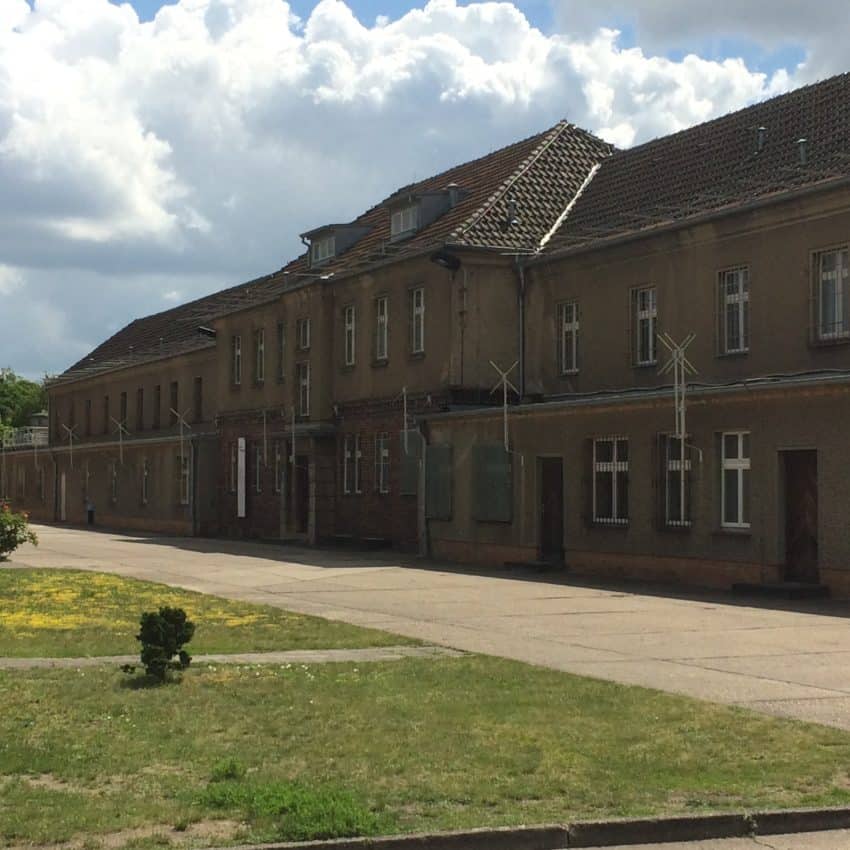
But then the tram dropped me in the neighborhood of Hohenschonhausen, the prison’s name which for 45 years sent chills through the spines of East Germans from Dresden to Rostock. On the street I saw parts of East Berlin’s gentrification: a kabob restaurant, a modern supermarket, a sandwich shop where a nice guy pointed me to the street for the prison.
I could see it at the end of Freienwalder Strasse. A four-story fortress made of red brick on the first two stories and yellow brick on the upper two. The barbed wire and guard towers remain on the corners as I entered. I noticed something odd diagonally across the street: a youth hostel.
No, this is not your father’s East Berlin.
You can only see the prison by an excellent 6-euro tour and ours started with a 30-minute documentary. A few chilling nuggets about East Germany:
* When World War II ended and the Soviet Union took East Germany in the distribution, Josef Stalin was the man in charge of East Germany. Under Stalin 100,000 East Germans were sent to special camps.
* After 1949 when East Germany formed, 2.6 million left East Germany.
* After the wall was built in 1961 to prevent the escapes, 1,000 were killed at the border.
* At one time, 91,000 people worked for Stasi, either as officials or unofficial spies. By comparison, only 7,000 worked for the Nazis.
* Between 3,000-4,000 prisoners died and were buried on the prison grounds, despite most never being convicted of a crime.
* In the prison’s 45 years of operation, no one ever escaped.
* On East Berlin maps, the prison’s location was represented by a large white unmarked space.
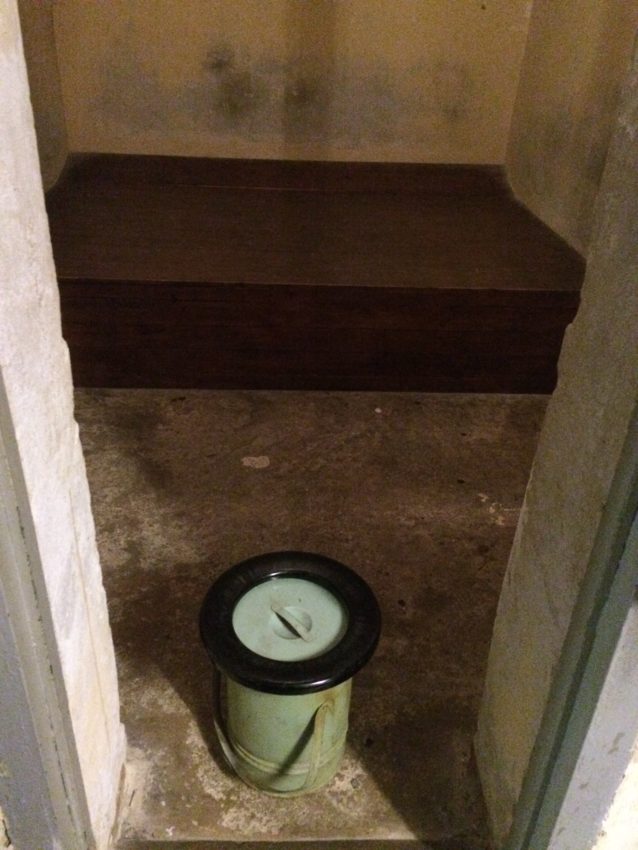
Our guide, a calm, pleasant Dane named Jesper, took about 15 of us English-speaking visitors on a 90-minute tour that left me shuddering a little as I left. We started in the basement of the original building, back when the Soviets ran the place. Compared to the Soviets, the East German officials were school marms with rulers. Physical torture was the Soviets’ MO and we saw the torture chambers in the basement known as “The Submarine.” They called it the submarine because prisoners who worked in submarines had the same feel of claustrophobia.
We walked into a dingy room about 20 feet long and 10 feet wide. The yellow and white paint was caked with 30-year-old dirt. We were told not to lean on the walls or paint might fall onto our clothes. This was once two cells. A wall has since been removed. Each cell imprisoned eight to 12 men. It consisted of one large bed with no mattress, covers or pillows. The light was on every hour every day, giving the Submarine the nickname Hotel of Eternal Light. During the day, no one was allowed on the bed. They had to cram together on what remained of the floor. A bucket in the corner served as a toilet. There was no water.
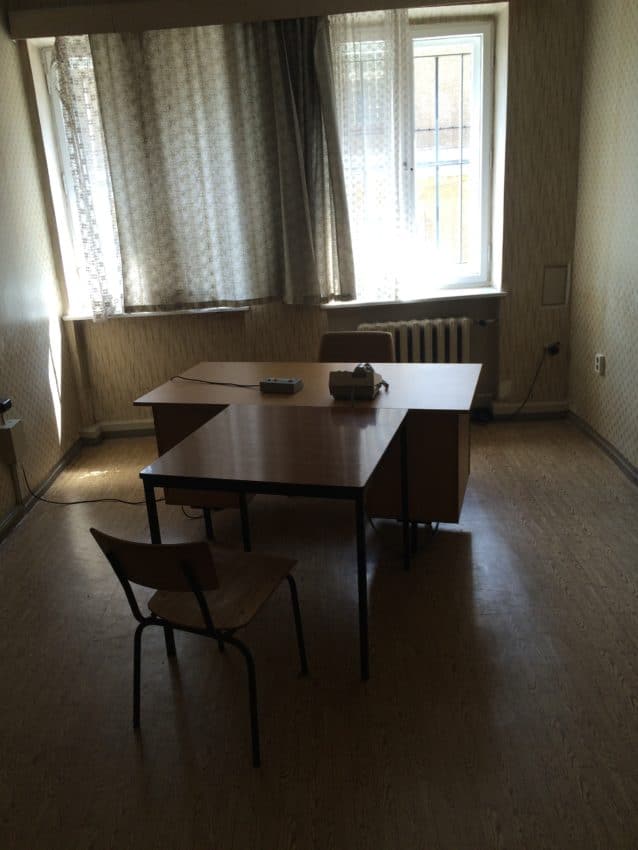
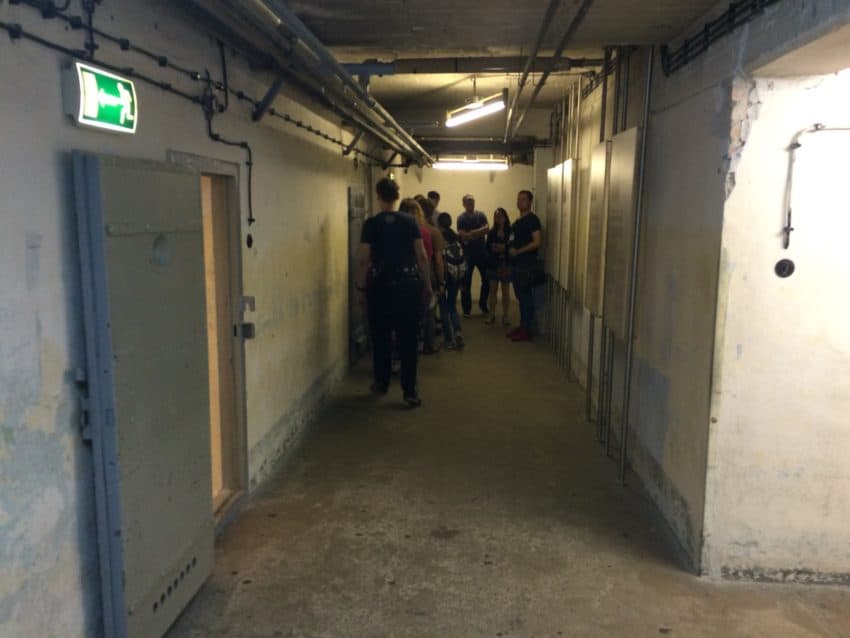
And they weren’t allowed out.
The ventilation consisted of a tiny vent in the upper corner of the roof. When it reached the ‘90s in the summer, it was over 100 in the cell. They were allowed to wear only the clothes in which they were arrested. If arrested in the winter, you had to wear your winter coat in the steaming cell. Food consisted of stale bread and thin soup.
If a prisoner could no longer take it and confessed to a crime he didn’t commit, the Soviets sentenced him to 25 years in a Siberian labor camp. Or, if they were lucky, they were executed. No one knows exactly where except the Russians. The documents are in Moscow and the Russians won’t release them.
The prison got worse. In 1953, East Germans staged a major uprising in East Berlin. It failed miserably. From 45-50 East Germans a day were thrown into the Stasi prison, putting up to 30 people in a cell. I asked what happens when they get sick.
“Sick?” Jesper said. “Bad luck for you.”
As we left, I noticed something: In the 10 minutes in the cell with 15 people, the heat inside had noticeably risen.
After the Soviet Union allowed East Germany to operate as a state in 1949, it gave control of the prison in 1951. They closed the Submarine and built the third and fourth floors of yellow brick. Then the torture went from physical to mental. The East Germans built standing cells in which one prison stood in a cell the size of a phone booth. All day. All night. He was not allowed to lean against the walls. Sometimes they’d pour water from above above their ankles. In winter, standing that long in freezing water could cause heart attacks.
The prison tore down the standing cells when the prison closed in 1990 but we saw plenty of others. All consisted of a short, flat, wooden bed only 4 ½ feet long. To prevent suicide, the prisoners were ordered to sleep only on their back with their hands folded across their chest. Guards came by every 15 minutes on position checks.
One upstairs hallway consisted of nothing but interrogation rooms. The prison had 200 of them. Each one had two adjacent tables, a phone and a recorder. Prisoners were brought in before Stasi officials who had Ph.Ds in — yes, they offered this major in East Germany — interrogation. They sat in the chair for six to eight hours, their hands planted under their legs, until confessing. Someone asked about defense attorneys.
“There were less than 50,” Jesper said. “They were for thieves and for minor crimes.”
The prison remains such an iconic representation of East German oppression, parts of the 2015 thriller “Bridge of Spies” was filmed here. Star Tom Hanks, in an attempt to get a better feel for the subject, turned down a fancy dressing room on the lot and instead had it on the top floor of the prison, forever endearing himself to the German staff.
As we left, I asked Jesper what Berlin schoolchildren are told about East Germany and the Stasi.
“I hear not much,” he said. “But we get a lot of German school groups come through here.”
Germany is littered with concentration camps open to the public. How many Americans have gone through slaves’ living quarters? Where is the Vietnam War Museum? It’s in Ho Chi Minh City, that’s where. It is called the American War Museum after a change from the more appropriate Museum of American War Atrocities.
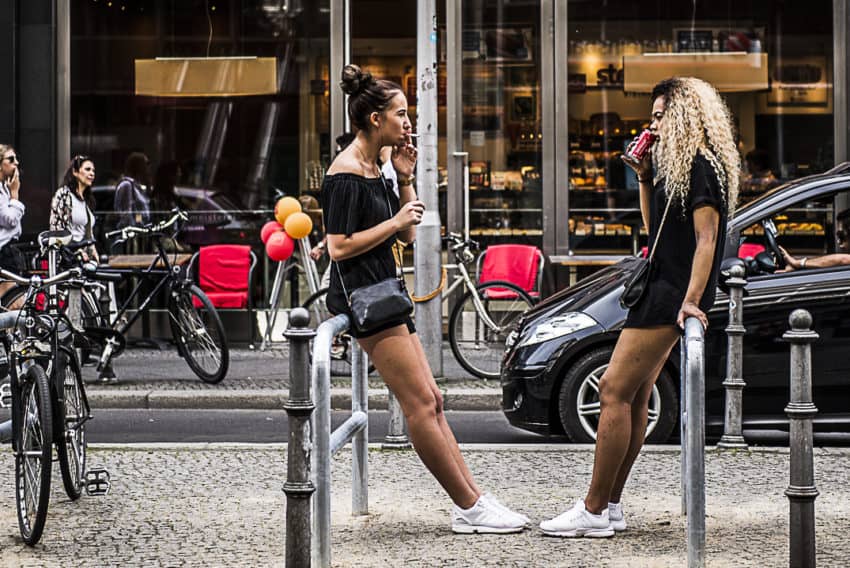
When I returned, I never thought a hotel room would feel so good but I’d never visited an East German prison before, either. We stayed at the Hotel Palace Berlin, a five-star beauty with a disappointingly frigid spa. It’s located in City West which so well represents the new Berlin. We window shopped up and down Kurfurstendamm, Berlin’s busiest shopping street featuring some of the top brand names in Europe. That doesn’t count Bikini Berlin, Berlin’s first concept mall across the street from the hotel. Built in 2014, it gets its name from the construction of a blank level covered by glass between two floors of shops, giving the concept of a two-piece swimsuit. Get it?
Since 2005, Berlin’s economy has outpaced the rest of Germany. So many tech companies have moved here, it is known as “Silicon Valley on the Spree.” Tourism has become huge with 12 million visiting in 2015, not including 100 million day trippers. The unfortunate side effect is the rents in this once-notoriously affordable city are no longer cheap. Builders are more interested in high end for the new elite than the rank and file German.
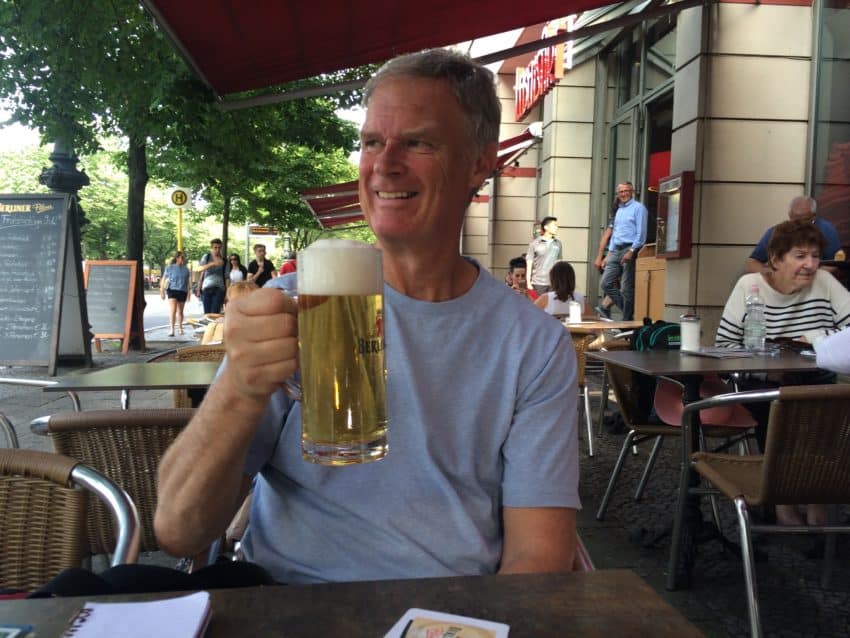
Berlin’s food scene is also exploding. It has become very trendy with Berliners flocking to new restaurants featuring German regional cuisines using only regional ingredients. With 620,000 residents from 190 countries, Berlin has an ethnic food scene that exploded our minds coming from Rome where all the ethnic restaurants could fit on one street corner. Our first night we went to Katz Orange (Orange Cat), a typical farm-to-table restaurant built inside an old brewery. We sat at the bar and tried a wide variety of German wines from the friendly bartender with an easy pour. I never liked German reds before but if you ever get a Cabernet-Merlot blend from Abril in Baden, try it. It’s best German red I’ve ever had. Of course, the free range sausage with potato salad made me swear off American hot dogs for life.
On our last day, a Sunday, Berlin changed. The city closed down some of the major boulevards and hundreds of cyclists took to the streets. Traffic cops held us up from crossing the street as a pelaton a kilometer long passed before us. Old. Young. Male. Female. Racing bikes. Mountain bikes. Cruisers. Everyone in Berlin seemed out doing something active. Marina and I noticed something else. Despite German cuisine’s fatty reputation — although I could live on sausage and beer the rest of my life — people in Berlin seemed remarkably fit. Berlin reminded me of Sydney in how active people are.

We eventually made it to the S-Bahn, Berlin’s super efficient surface train system, and went to Tiergarten. This is Berlin’s Central Park. It is 1,277 acres of grassy lawns, small lakes and streams. We went to a supermarket and picked up some fried chicken legs, salami, cheese, cherries and a bottle of German Riesling from the Rhine Valley. Tiergarten is spotless. I didn’t see a single cigarette butt, not one plastic wrapper. Nothing. Plenty of people slowly cycled down the bike paths, one hand on the handlebars and the other on a bottle of beer.
We spread a towel along the banks of the river and took out our spread as swans slowly floated by. Berlin was hot, in the mid-80s with high humidity. But in the shade of one of the thousands of big trees, it felt like a cool spot on a romantic beach. And I don’t recall a chicken leg ever tasting this good. It’s also a pretty good pairing with Riesling.
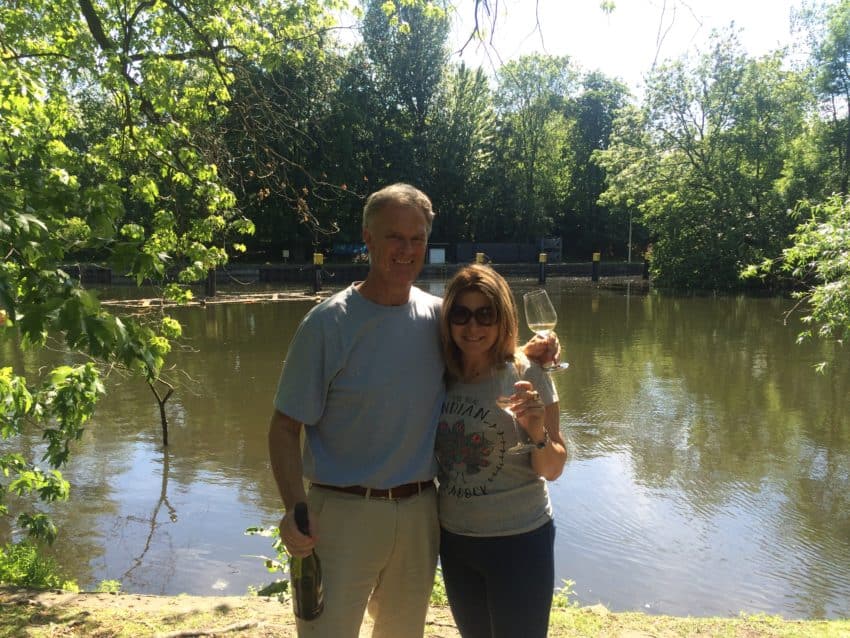
We came home with a few regrets. You need more than three nights to enjoy Berlin. A savage abscessed tooth that put me in the dentist’s chair much of Friday put a dent in the trip. Getting examined by a dentist in the shadow of the Stasi prison and “Marathon Man” being one of my favorite movies only added to the stress.
But we survived to make it back to Rome where I immediately watched “Bridge of Spies” again. The movie has a happy ending. That’s fitting. Berlin has a happy ending, too.


June 19, 2017 @ 4:52 am
Hi John. Good report (as always!). I’m off to Berlin in 10 days – What tram number did you use in the East? regards geoff
June 19, 2017 @ 11:16 pm
Geoff: The tram to the prison is M5. It drops you off five minutes from the prison.
Find out the times of the tours. When I was there, they were at 10:30 a.m., 12:30 p.m. and 2:30 p.m. You can’t tour the place without a tour so time your arrival properly or you’ll be standing around a while. Actually, go about an hour ahead of time. There’s a free exhibition displaying a lot of prisoners’ photos (and their experiences in German) and memorabilia from the prison in one of the conference rooms. It’s worth perusing before the tour. It’s a great tour but tiring. The Stasi Museum is a few kilometers away and many people try to see both in the same day. I didn’t. I was exhausted after the prison. The museum takes at least two hours just to see half of it. It’s huge.
Thanks for the kind note.